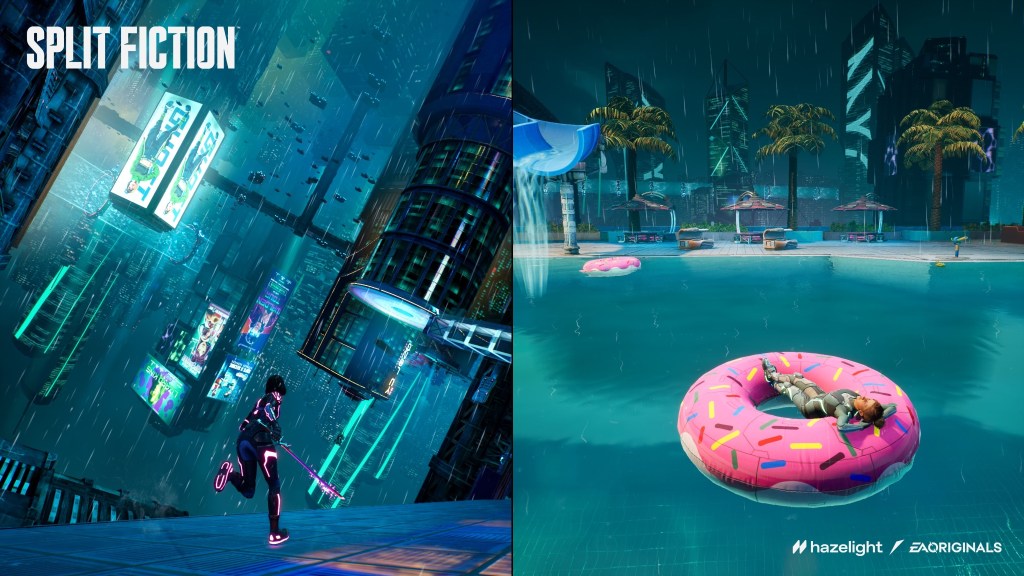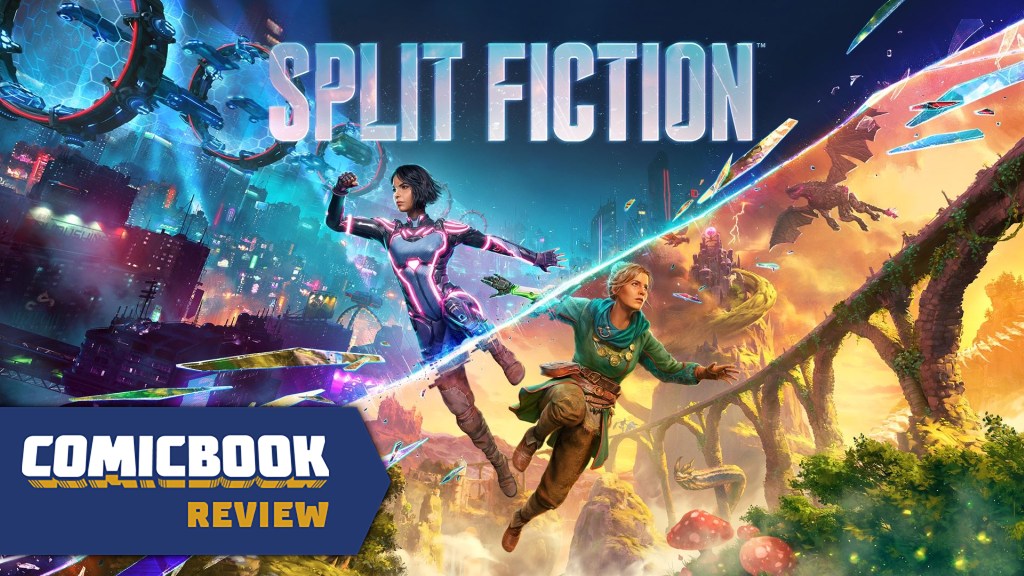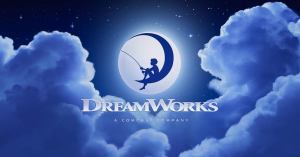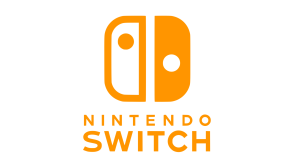When I was working in the food industry, my boss once told me a story about how an owner he knew had two restaurants: one that served American food and the other that only served wings. When he was asked which brought more profit, the wing shop took the top spot since it specified doing one thing and perfecting it. In a similar way, if there is one thing that Hazelight Studios and director Josef Fares have perfected, it’s crafting the best couch co-op games possible. And if this wasn’t already true before, Hazelight has again demonstrated its co-op mastery with its latest release Split Fiction.
Videos by ComicBook.com
Split Fiction follows Mio and Zoe, two aspiring writers who come to Rader Industries to sign a publishing deal with the company. Zoe is an extroverted fantasy writer while Mio is an introverted sci-fi writer; it’s the equivalent of water and oil mixed. However, the unlikely duo is accidentally paired together after Mio falls into Zoe’s simulation after learning that the revolutionary machine in which the authors get to experience their creations is designed to steal story ideas as its own. Together, the two must traverse the dueling worlds to glitch out the system and stop it from taking their work to Rader’s disposal. The game sets up the duo rather quickly, creating a bond that can only be forged through continuous collaboration and communication.
Those two qualities are essential to the storytelling and gameplay experience of Split Fiction, as you will be required to work through some of the most innovative co-op puzzles. Just when you think Hazelight has pushed the co-op boundaries of gameplay, each level brings a refreshing collaborative touch that keeps the game from sticking to simply telling a story. The puzzles start strong with creativity and continue to strive in unconventional ways by owning outlandish ideas and embracing them. Turning into a pig that farts rainbows isn’t a common gameplay experience one typically gets, but in Split Fiction, it works. The addition of a grappling hook is also a game-changer in regards to exploration, especially during the times when taking the scenic route wasn’t an option while running away from a menacing crowd of ogres.
I admired the contrasting stories between Mio and Zoe, which allows players to indulge in many different styles. The sci-fi world is a futuristic utopia crawling with enemies, which provides players with a fast-paced, action-packed twin-stick shooter filled with gravity-defying stunts, while the fantasy setting offers a fairy tale that is sprawling with mythical creatures, luscious scenery, and environmental-specific puzzles. I was a bit underwhelmed at the thought of only being able to go through a sci-fi and fantasy setting, but the exploration and innovative level designs, including the ones during the several boss battles, kept the game fresh instead of repetitive.
Some of the levels wore their inspiration on their sleeve, with moments switching from intense camera-angled shots reminiscent of The Matrix to then taking on a 2D sidescroller perspective that brought back memories of Metroid and Sonic the Hedgehog. The many ways to explore the different worlds are incredibly ambitious as we get to stand on the shoulders of rock-climbing giants, traverse the sands on a sandworm Dune-style, and even fly while using your grappling hook to soar across the sky filled with kites.

One sci-fi level has Mio wielding a cyber-kinetic sword and magnetic wall-climbing abilities while Zoe uses an energy lasso, which comes in handy when throwing objects out of the way and throwing enemies into the distance. In the fantasy world, one specific level will have Mio as an animal shapeshifter and Zoe as a fairy, with one able to traverse on the ground and the other by air. The gameplay mechanics are everchanging but make it easy to transition from one ability to another, regardless of which character you play. During my playthrough, I played as Zoe, but whoever you choose, the difficulty doesn’t change. Each level is designed to cater to the abilities of each character while making sure to hone in on the co-op aspect of the game. This also introduces the opportunity for replayability as Mio and Zoe both offer different ways of offering new gameplay experiences.
The narrative beats between Mio and Zoe are spread out along its 12 to 14-hour experience, taking opportunities to expand on these characters and to learn about each through their writing. Being able to explore the worlds created by Mio and Zoe gives a glimpse into the places that these authors go to escape reality, which is explored throughout the game. Seeing how their stories played a role in their own lives was intriguing to learn over time, which was insightful to recognize as a writer myself. There’s a saying that the essence of yourself can always be seen in your work, which Split Fiction dives into headfirst, crafting a story that is within itself a reflection of the author’s hidden virtues. Co-op games typically aren’t something you would associate with storytelling, but Hazelight has always been able to craft a multiplayer experience that tells a dynamic narrative through its levels.
Although the two stories are the main attraction, some of the most creative levels come from the Side Stories, which are scattered across the different missions. Being someone who loves improvisation, I can only imagine the level of thought that went into taking the traditional and going one step further. One of the most bizarre levels sees Mio and Zoe turning into molars who go through a sugary land filled with cake, candy, and a killer dentist who only wants to cause them harm. While I won’t spoil all of the surprises, these specific stories stem from Mio and Zoe’s younger years and showcase the wonders of a child’s imagination. All of the levels, including this one, didn’t feel out of place since they made sense with the story, which I found to be intriguingly valuable.

For someone who adores It Takes Two, Split Fiction ups the stakes, providing a spellbinding adventure that can only be witnessed alongside a friend whether through couch co-op or Split Fiction Friend’s Pass. Having played alongside my twin brother, we couldn’t help but enjoy the chance to experience a game together which prompted excited nostalgia. We were consistently in awe over the different approaches to the co-op gameplay level designs. There were moments, especially the third act, that had us pleasantly shocked, with others causing pure amusement and awe over what Hazelight accomplished.
Hazelight Studios is far and away the preeminent studio for co-op storytelling. There has never been a game like Split Fiction before and, frankly, it’s hard to think of one that could match this creative quality ever again. Split Fiction is an example of director Josef Fares’ ability to capture the child-like creativity of storytelling and continue to curate the best cooperative games to date. The scale for Split Fiction is massive and there is no shortage of dullness in this colorful display of one’s imagination gone wild. Being able to play a co-op game with someone else feels right as it provides a sense of togetherness that is rare to come across these days. Split Fiction reiterates this need to tell stories that can be experienced and enjoyed alongside others.
Rating: 5 out of 5
Split Fiction releases on March 6th on PlayStation 5, Xbox Series X|S, and PC. A complimentary copy of the game was provided by the publisher for the purpose of this review and played on PlayStation 5.









